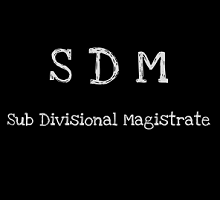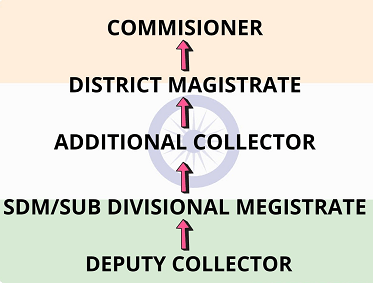SDM - Sub Divisional Magistrate
SDM stands for Sub Divisional Magistrate. The Sub Division of any District is headed by the Sub Divisional Magistrate. He is an administrative officer who works at a level below the administrative level of the district. During their training, the officers of Indian Administrative Services also serve as the Sub-Divisional Magistrate. In many states, these IAS officers are named as Assistant Collector or Commissioner. Tax inspectors, also known as the Collector of District Magistrate. Sub-Divisional Magistrate takes charge of all the tehsils. There are various roles of a sub-divisional magistrate in the Criminal Procedure Code 1973. The IAS Officers begin their district training with the home cadres. It is followed by their first posting, and the Sub Divisional Magistrate (SDM) is their first role. Therefore, they are made in charge of the district sub-division. SDM role can also be given to a senior State Civil Services Officer but only after relevant work experience in subordinate roles. Definition of the Sub Divisional Magistrate as per law
Functions of Sub-Divisional Magistrate1. Revenue Functions -Following are the revenue functions of the sub-divisional Magistrate -
Revenue work is one of the most important function that the Sub Divisional Magistrate is required to follow. The Girdavars, Kanungos and Patwaries are subordinate staff for the revenue work. The Tehsildars inspect all revenue activities at the field level and supervise the revenue staff. Another authority of the sub-divisional Magistrate is to issue statutory certificates such as SC/ST & OBC, Domicile, Nationality etc. Additionally, the documents that are mandatory to be registered as per the law are registered at the Sub Registrar's Office. There are nine Sub Registrar's Offices. The documents that are compulsory to be registered are property documents, sale deeds, power of attorneys, and share certificates. The Deputy Commissioners exercise control over the Sub Registrars, as they are the Registrars of their district. 2. Magisterial FunctionsThe Sub Divisional Magistrate have role to conduct the preventive Sections of the Code of Criminal Procedure. This function is part of their Magisterial role in which they exercise control over the Executive Magistrate. Another function is to set an enquiry for the unnatural deaths of women. After enquiry, they direct police to register the case, if required. They are also responsible for the inquiries in death cases such as police lock-up, jails,etc. The Officers also act as a witness for the Government and report the Government after enquiring about major accidents like natural calamities, riots, and fire incidents. 3. Disaster ManagementThe disaster management department is responsible for the operations in case of any calamity. It provides relief and rehabilitation to people in natural or man-made disasters. It also conducts various programmes to spread awareness and disaster management during a calamity. It monitors the disaster preparedness for the disasters like chemical disasters. Power of the Sub-Divisional MagistrateThe Sub-divisional Officer is a miniature Deputy Commissioner for the respective Sub-Division. SDM is empowered to coordinate in administration and all matters of their respective Sub Division. He has the authority to exercise power over the Tehsildar and the staff. He is directly in coordination with the Government and the other departments for routine matters. The main responsibilities of the deputy commissioner are revenue, judicial and executive related work.

Roles and Responsibilities of an SDMSub Divisional Magistrate (SDM) is the initial position given to an IAS officer who is selected through the UPSC Exam. The career of an IAS officer begins with their training, after which they take responsibility as the Sub Divisional Magistrate (SDM). An SDM is responsible for a Sub Division in a District. They have many roles and responsibilities that help in the effective administration of the district.He has to be the Deputy Commissioner's principal agent in all matters of relevance. All these affect the people in the Sub Division directly or indirectly. The major responsibilities of the Sub Divisional Magistrate are listed below -
Although the Sub Divisional Magistrate holds a position independent, his decisions can directly affect the people. He is responsible for everything and all matters within his jurisdiction. Hence, SDM must take decisions independently. He acts as the appellate authority in cases decided by revenue officers who are his subordinates. How to Become a Sub-Divisional Magistrate?The first post of an IAS is SDM. To be eligible for the examination for becoming an SDM, a candidate must have graduated from the Government recognized institution. The candidate must appear for the CSE examination conducted by the UPSC. The candidate who is successful in the UPSC CSE examination becomes an IAS officer. Educational Qualification for SDM RoleThe candidate must have graduated from the Government recognized institution in India. Graduation is the mandatory qualification for the position of an SDM. The candidate can apply for the CSE examination from their final year in the graduation. The key solution for the query how to become SDM After the 12th also remains the same as mentioned below. The candidate can apply for the examination from their final year in the graduation. But you can start your exam preparation immediately after the 12th. As the UPSC exam is one of the toughest competitive exams in India, so you to start preparing beforehand. UPSC Examination Eligibility1. Nationality of the Candidate
2. Educational Qualifications necessary for UPSC examination The educational background of the candidate must consist of any of the following mentioned degree or qualification-
3. Age Criteria The general category candidate must be between 21 and 32 years of age to be eligible to appear for the examination. This age limit must be till the August 1 of the year of examination. The age limit is influenced by the category if the candidate belongs to the reserved category.
Number of Attempts in the UPSCThe number of attempts for examination also differs according to the caste. General category candidates have six attempts at the exam. OBC category candidates have nine attempts at the examination, whereas ST / SC candidates can give unlimited attempts until 37 years of age. Importance of SDMThe districts are the administrative divisions of a state that are further divided into Sub Divisions for the smooth and efficient functioning of the system. These Sub Divisions are run by the Sub Divisional Magistrate, Sub Divisional Officers, and the Tehsildar. SDM facilitates the working of large Tehsil of District. He is crucial in the revenue work as he acts as the assistant to the land revenue. He supervises whether the laws are implemented or not and can issue orders accordingly. He is also empowered to arrest, release an order to use tear gas whenever required, and cover areas during the curfew. SDM has the authority to assist the District Magistrate in clerical work. He acts coordinator to the District Magistrate and assists him. He is also empowered to set an independent enquiry in any case if required. An SDM can be an IAS officer or a PCS Officer. SDM is important for the efficient functioning of the Sub Division as they execute financial, administrative, judicial work and maintain law and order.
Next TopicGPS - Global Positioning System
|
 For Videos Join Our Youtube Channel: Join Now
For Videos Join Our Youtube Channel: Join Now
Feedback
- Send your Feedback to [email protected]
Help Others, Please Share










